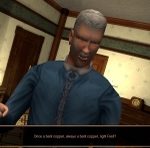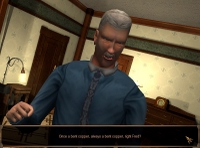On And Then There Were None

Lee Sheldon describes his playable adaptation of Agatha Christie's And Then There Were None, which relies on his invention of a "suspicion meter" to quantify and track the player's interaction with - and assessments of - NPCs (non-player characters).
Adapting anything from one medium to another offers many more challenges than an original work coming to life on the canvas for which it was intended. Retooling Agatha Christie’s classic mystery novel And Then There Were None (ATTWN) as a game for the PC - the first time any Christie story has been made into a game - is a case in point.
ATTWN is a graphical adventure game set on a storm-swept island off the south coast of Devon, England. In the original novel, ten strangers, each harboring murderous secrets of their own, are lured here and killed off one by one. In a departure from the many adaptations of this famous story in other media, an integral eleventh character is also added to the game: the player character. This is the boatman, Patrick Narracott, who brings them to the island, a man with his own secrets. The gameplay consists of the player acting as amateur detective: attempting to find clues to the identity of the diabolical killer, save as many of the intended victims as possible, and to either find a way off the island or to summon help.
The novel is filled with character interaction that needed to be replicated, both player-NPC and NPC-NPC. Much of this takes place in dialogue, as all of those trapped on the island take part in an increasingly frantic roundelay of interrogation, speculation, and accusation. While true to the original novel, this somewhat upset the balance between gameplay and story that I always strive to maintain. All I could do was try to make the talk as entertaining as possible, and hope the player didn’t grow too restless.
I also added a romantic rivalry for the affections of the young former governess, Vera Claythorne, between the player character Narracott and adventurer Philip Lombard. As for the investigation, NPCs can aid the player, or thwart the player’s efforts. In a nod to the infamous pirate from Colossal Cave, the first adventure game of them all, the fastidious butler may relieve the player of inventory items Narracott has collected that are not rightfully his. And the player must contend with attempts upon Narracott’s life by a killer understandably annoyed by the presence of this outsider, who could wreck his carefully constructed plot built around a nursery rhyme that allows for only ten little victims.
For me, one of the most interesting challenges was creating gameplay that fit with the key conventions of Christie’s particular brand of mystery story. Some translated easily to gameplay: surveillance, rifling through the belongings of suspects, examining fingerprints, and medical forensics (mercifully simple given the time period the story is set in - pre-World War II - and the isolation of the island). The presence in the cast of both a doctor and judge helped with questions medical and judicial. The requisite storm added to the atmosphere, as well as helping to limit the movements of the player character when necessary to the design. And I called upon Christie’s brief historical footnotes to her fictional island, as well as the true history of that stretch of Devon coastline, to create a somewhat larger island with more interesting nooks and crannies to explore, and more obstacles to bedevil the player.
Other conventions needed a bit more thought. But I realized I had a golden opportunity to not only add a layer of gameplay that would be true to the story, but at the same time banish a personal bête noir of my own, common to adventure games.
Exploration is an essential element in many types of games, from solo shooters to massively multiplayer worlds. In adventure games the player character is often allowed to enter any room, either by wandering in, or first solving a puzzle to gain entry. Sometimes those rooms are occupied. Often they are occupied by NPCs, who have more right to be there than the player character. We know what would happen in a shooter: gunsmoke and blood sprays. In an adventure game, the NPCs (maybe fearing they’re actually in a shooter) usually fidget in place with fixed smiles on their faces, while the player character paws through their most personal possessions under their very noses.
In ATTWN, NPCs react to the player character’s invasion of their privacy. If Narracott creeps into a bedroom and begins going through someone’s belongings, a confrontation may result:
INT. BLORE’S ROOM - DAY
Once the player has turned to the page in Blore’s notebook where Blore describes recognizing Narracott and plans to scuttle the boat, Blore enters. (-1 on suspicion meter)
Blore: Once a bent copper, always a bent copper, right Fred?
Blore takes the notebook away.
After a brief dialogue, the player can choose to leave, or will be firmly escorted from the room. Notice that reference to a suspicion meter in italics?
In mystery stories, we have another convention: the shifting of suspicion from one suspect to another. This is easy to do in the game. But often, the suspicion also can fall on the investigator. If not suspected of the actual crime, the detective’s motives can be murky. Suspects become less cooperative. It was the second case I wanted to play with, so I created a simple Suspicion Meter. This is not a part of the interface, but a behind-the-scenes method of tracking the relationship of Narracott to the others in the game. There are only three states, although obviously it could have been more elaborate. They are Positive (+1), Neutral (0), and Negative (-1). The player begins the game in the Neutral state. If Narracott is caught by an NPC doing something that would appear suspicious, the player loses a point with that NPC. If Narracott aids an NPC, the player gains a point.
The NPCs’ answers to questions and willingness to cooperate with Narracott’s plans depend on the state. Here are two possible replies to a question the player chooses to ask, depending upon his current standing with the NPC Lombard:
You said you recognized Owen’s voice?
(+1 on suspicion meter)
Lombard: Alright, Narracott, I’ll tell you. I was hired by Archibald Morris, the non-existent Mr. Owen’s attorney. He first made contact with me over the telephone. It was Morris’ voice on that recording, I’d swear to it.
(0 on suspicion meter)
Lombard: I’ve had time to think it over and I’m sure I did. But I see no reason to share that information with you.
Since the -1 state can result in a refusal to answer questions or cooperate at all, and as can be seen in the example, the 0 state is not always very satisfying. And since the +1 state always provides more information, there is at all times a way to get back on an NPC’s good side. Here is an example from the design document page for one of the NPCs, Emily Brent:
Range
Emily can most often be found knitting on the front patio.
Suspicion Modifiers
+1 Obtain apple juice
+1 Quote from bible
-1 Caught in her room
-1 Caught in a lie
Useful Information
Emily knows quite a lot about Cyril Hamilton, the boy who died while Vera was his governess.
The result of NPCs reacting to the player character’s actions, and the subsequent effect on the player’s investigation, means that players cannot simply steamroll past the NPC encounters in the game. The NPCs are real characters with opinions of their own, and they must be treated accordingly.
Any attempt to use gameplay to bring NPCs more fully to life is a worthy one, in my opinion. I’ve presented here only one example of story and gameplay working together, instead of being segregated. Gameplay and story need not be at odds with one another. And story need not be confined to the ghetto of cinematics.
Reference
And Then There Were None. Awe Games. 2005
Cite this article
Sheldon, Lee. "On And Then There Were None" Electronic Book Review, 18 February 2008, https://electronicbookreview.com/publications/on-and-then-there-were-none/
